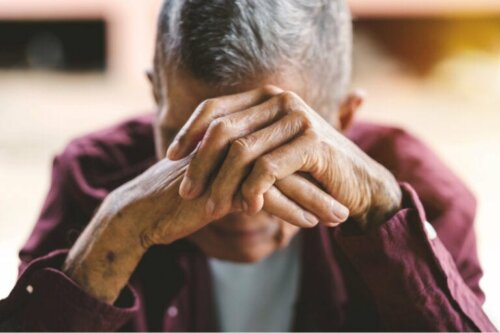We’ve all heard of strokes, but what are they in reality? In fact, they’re cerebrovascular accidents (ACV) that happen when a blood vessel breaks or is clogged. Due to this breakdown or blockage, part of the brain doesn’t get the nutrients it needs and the nerve cells die.
After this, the sufferer might experience a series of complications. They can be physical, cognitive, and emotional. The physical manifestations are more evident, while the emotional alterations, in particular, anxiety, sadness, crying, or anhedonia are often less visible. Among these emotional alterations, is post-stroke depression.
Post-stroke depression refers to major depressive symptoms after a brain injury. Symptoms usually appear in the first three months after the stroke (early PSD) and less frequently later (late PSD). It can arise while the sufferer is trying to adjust to their temporary or permanent disability.
Below, we’re going to explain what you should know about the symptoms of post-stroke depression.
Emotional symptoms
In this disorder, there can be sadness, anhedonia, and even excessively intense laughter. There can also be catastrophic reactions. For example, sudden excessive crying, outbursts of anger, or fear in the face of failure of completing a task. On the other hand, the sufferer may be unaware of their physical limitations and thus exhibit indifference to their disability (anosodiaphoria).
One of the emotional effects that sufferers exhibit is apathy. This is a lack of initiative and activity. In fact, according to psychiatrists, psychologists, and the families of those affected, it’s the most frequent symptom of post-stroke depression.
Behavioral symptoms
Fatigue or post-stroke fatigue is characterized by the fact that the sufferer manifests intense fatigue, a subjective feeling of exhaustion, and constant difficulty in starting any task.
In turn, they feel constantly irritable and exhibit certain aggressive behaviors, either toward objects or people. Moreover, they become more rigid in their plans. For example, they demonstrate the inability to change preconceived plans due to unforeseen situations and also show negative reactions to them.
Cognitive symptoms
As a rule, most cognitive functions are affected (attention, perception, memory, language, etc.). However, executive functions that reflect the ability to organize, prioritize, manage time, and make decisions are the most affected.
Given these symptoms, it’s important to know what to do in the face of this kind of depression.
Treatment of post-stroke depression
Most experts recommend antidepressant medications. They must always be prescribed by a psychiatrist and, if they’re familiar with strokes, even better. In addition to a psychiatrist, a psychologist can be helpful.

It’s also important for the sufferer to have a physiotherapist for physical rehabilitation and structured activities, as they help reduce levels of depression.
Post-stroke depression is a significant clinical entity. The sufferer can’t overcome it simply by wishing it’d go away, or by using willpower, or ‘being strong’, especially since their life has taken an unexpected turn. Indeed, adaptation is a process.
Finally, to understand a little better how a sufferer of post-stroke depression feels, we might describe it as an individual looking at themselves in front of a shattered mirror. They now see their reflection in several pieces, whereas before it was in one piece.
These pieces represent the fear of a new way of living along with other changes. The sufferer may well be suffering from low self-esteem, and be constantly concerned about their health. They might also feel uncertain and even worthless.
Emotional and Behavioral Changes Brought on By a Stroke
The post Post-Stroke Depression appeared first on Exploring your mind.ok



















Comments